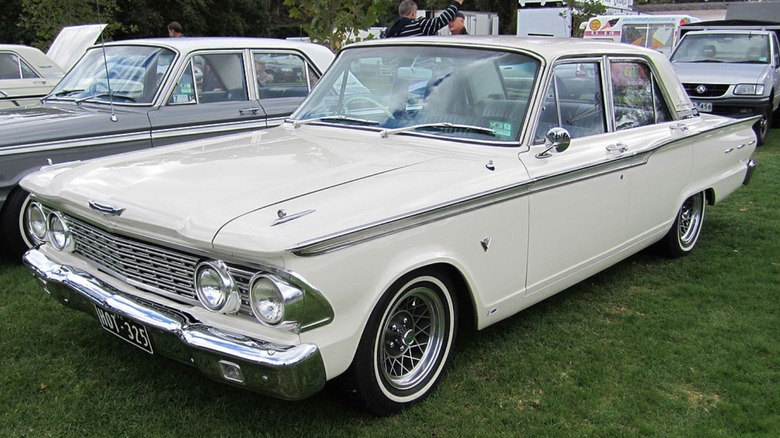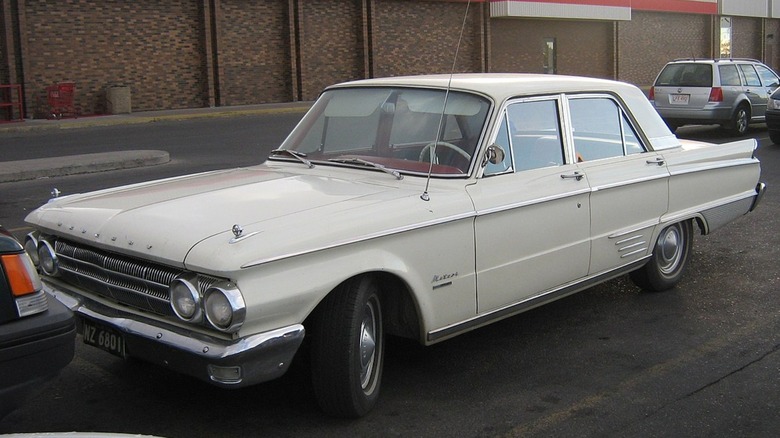Ford's 221 V8 Engine: The Blue Oval's First Small-Block
Ford has created some iconic vehicles over its long history in the industry, from the Explorer to the classic Model T. The vehicles themselves, of course, serve as the most prominent work an auto manufacturer produces, but some of the most innovative work — such as engines and driver-aid technology — can exist under the hood as well. For Ford in particular, one important example is the V8 engine family.
Drivers of modern Fords will probably be familiar with the likes of the EcoBoost engine family, which debuted in 2009 and is focused around enhancing efficiency without losing out on power (utilizing direct injection). Decades before EcoBoost technology was introduced, the company was experimenting with small-block engines for its vehicles. An early fruit of this labor was the Ford 221 V8, which first arrived in the model year 1962.
It was an era of increasingly large vehicles packing increasingly large and formidable engines, but this isn't to say that their small-block counterparts couldn't make waves, too, as the 221 V8 would go on to demonstrate. Let's take a closer look at this venture into small-block engine territory, how it evolved as the family grew, and which of Ford's vehicles it powered. Remember: small-block doesn't mean small potential or small power.
[Image by Sicnag via Wikimedia Commons | Cropped and scaled | CC BY 2.0]
The introduction of the V8 small-block
Though U.S. appetites for mighty rides are well known, some of the most acclaimed vehicles of all time have been a bit more modest than you might expect (proportionally speaking). During the 1960s, the Ford Mustang — which arrived in 1964 — and the Volkswagen Beetle would rise to great popularity. These are two very different models that spoke of the importance, both to the industry at large and individual manufacturers, of diversity. To this end, Ford strove for a way into the small-block arena.
The U.S. auto giant wasn't the first to do so. Chevrolet's acclaimed V8 small-block (which marked an astonishing 100 million units manufactured in 2011) had launched in 1955, first powering that model year's offerings such as the Chevy Bel Air. The year before, Ford had introduced a unique engine of its own: The Y-block, a V8 with an overhead valve design that was a first for the company. What Ford then wanted to do was build upon the established foundations of this bulky engine to create a more practical and potentially more versatile powertrain. The cornerstone of that powertrain would be the Ford V8 small block.
The 221 V8, so named for its displacement, was the first addition to the family. It was first incorporated in Ford's vehicles for 1962, and though the company's Bowtie rival had established its own small-block eight years before, the 221 would prove itself to be far more than an imitation of the Chevy V8.
What Ford's 221 V8 was capable of
The size and weight of a vehicle can each have a detrimental effect on the other if overdone. A higher cylinder count may offer higher potential on paper, after all, but not so if the bulkier engine that results demands the vehicle works harder to support it. Larger engines can be impractical, and it pays to try and utilize the potential of a smaller model as much as possible. This is just what Ford did with the 221 small-block.
The engine was made to a lighter and thinner iron specification. V8 engines, typically heavier than their V6 counterparts owing to those sizable extra cylinders, may have seemed an ill fit for certain types of vehicles as a result. However, this formula helped to demonstrate that subtler V8s could be great fits for a new era of Ford vehicles. The 221, or Challenger V8, was first seen in a very appropriate model: the newly-mid-size '62 Ford Fairlane. The 3.6 liter engine afforded the model 145 brake horsepower.
The 221 engine was also supplied as an option for that year's Mercury Meteor, offering torque of 216 pound-feet of torque and gross horsepower of 145. The goal had been to develop an efficient, reliable V8 weighing no more than 450 pounds, How Stuff Works reports — and while this had been handily accomplished, it was an engine that could, and would, be improved upon.
[Image by dave_7 via Wikimedia Commons | Cropped and scaled | CC BY-SA 2.0]
How the plucky small-block developed over the years
The 221 was a $250 million task assigned to one George Stirrat. When it demonstrated that such a V8 could adequately power the Fairline (a model in a rather new area of the market at the time, size-wise), such a significant investment meant that Ford wanted to continue to develop the 221: Overboring allowed it to reach an enhanced output of 164 horsepower.
The base 221 would soon be replaced. By 1963, Ford had created a 289 cubic-inch V8, demonstrating that the growing engine family had what it took to power iconic Fords. Arguably the most iconic Ford of all, in fact: When the Mustang was released in 1964, it would go on to sport a 289 V8 Hi-Po — pictured above — as a potential powertrain (though not initially). This was the High Performance model; it earned the moniker with a significantly boosted output. The Hi-Po could hit 271 horsepower, a dramatic increase from the high of 225 horsepower that the 4V equivalent could offer.
This follow-up to the 221 V8 continued to exhort the message of the original: powerful things can come in relatively small packages. At times, the 221's short-block successors were experimental: the Boss 302 engine was first created by combining the 351 Cleveland and 302 Windsor, but they were significant parts of Ford's history and remained so even after ceasing development near the turn of the millennium.
[Image by sfoskett via Wikimedia Commons | Cropped and scaled | CC BY-SA 3.0]



